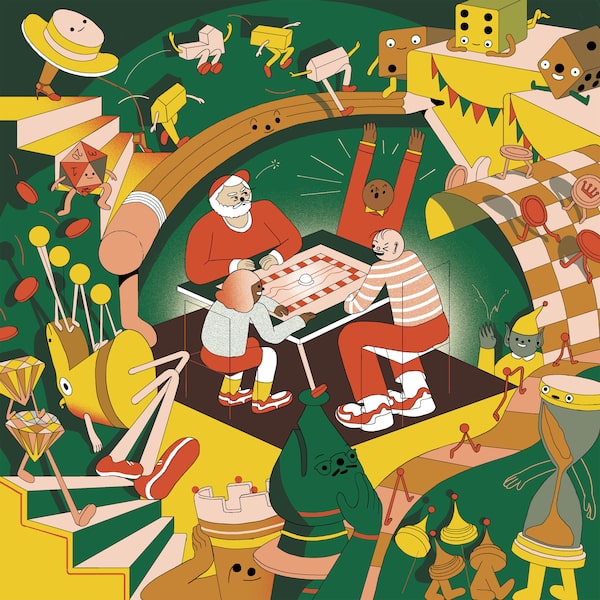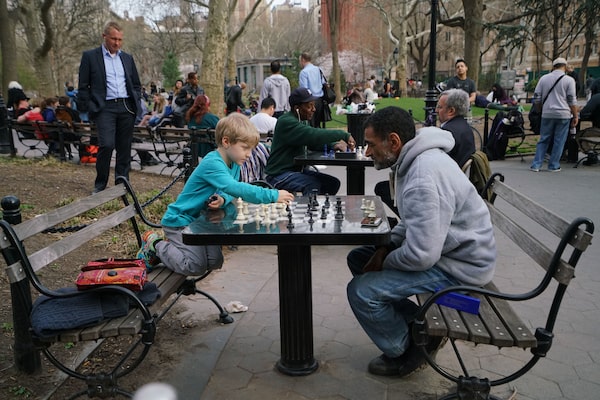
Illustration by Dalbert B. Vilarino
Jonathan Kay’s most recent book (co-written with Joan Moriarity) is Your Move: What Board Games Teach Us About Life.
Last month, the Parsons School of Design in Manhattan launched an exhibit on the history of board games called Eyes on the Board – Crossing Game Space. Many of the displayed pieces are related to mancala, an ancient board game family on which the exhibit’s Dutch curator, Alex de Voogt, is a world expert. But Eyes on the Board also contains other fascinating elements, such as biographical works on China’s female Go grandmasters, and a sixth-century poem by the Greek writer Agathias describing the exact state of play in a game of Tables, an early version of backgammon. “Board games serve as social lubricants, facilitating interactions between different groups of people,” wrote Dr. de Voogt in his curator’s statement. “For at least five thousand years, they have connected people across generations.”
When I visited Parsons on the exhibit’s opening day, the scene signified why the need to connect now feels so urgent: Visitors would drift in and inspect the exhibit as they listened to music on headphones, or absent-mindedly took pictures with their phones. Then they would drift out again. It has been documented how loneliness is affecting people everywhere. But New York can seem like an especially lonely place, because the hordes of young people who move here every year use social media to remain enmeshed in their old peer groups, instead of doing the hard work of making new friends. In a memorable 2013 essay about moving to the East Village, the British writer Olivia Laing described “a loneliness more paralyzing than anything I’d encountered in more than a decade of living alone.” If there is any spot in North America that cries out for the “social lubricant” provided by my beloved board games, this would be it.
Unfortunately, even amid the current board-gaming renaissance, New York has remained a mostly unwelcome place for board gaming. Yes, Bryant Park and Washington Square still attract daily gamers. And the Chess & Checkers House in Central Park sometimes gets hundreds of people a day on sunny weekends. But many small apartments in this city don’t even have a proper table, let alone an actual living or dining room. Manhattan has only two real board game cafés (Uncommons in the Village, and Hex & Company, way up on Broadway and 112th Street), as compared to the many on offer in my hometown of Toronto, because in a borough where ground-floor retail space tends to rent at an annual rate of at least US$300 per square foot, you can’t make money selling coffee and croissants to customers playing out a two-hour session of Settlers of Catan.
For serious hobbyists – the middle-aged nerds and subcultural hipsters who have whole bookcases full of games they bought on Kickstarter – the true board-gaming heartland remains the vast sprawl of suburbia and rural America, where siblings and school friends develop their love of games in basements and cottage porches. (It’s no surprise that North America’s two biggest board-gaming conventions are in midwestern cities, Indianapolis and Columbus.) This is especially true of the most elaborate and richly thematic games, such as Dungeons & Dragons, which are essentially forms of communal storytelling. Creating fictional worlds with dice and paper is hard to do when New York’s very real world of horns, sirens and crowds is constantly assaulting your senses.
Because the young people who come to a place such as New York become untethered from the family and friend networks within which most of passionate gamers develop their love of the hobby, they tend to find their gaming communities online – a poor substitute for actual social interaction. Digital media can be useful in preserving the memes and social memory of an established friendship. But they generally don’t allow those friendships to mature or develop, or to follow the organic process (that most of us experience in our teen years) whereby bilateral friendships become a seedbed for larger circles of friends.
Burgen Schwartz, left and Mark Tancig play checkers in the grass at the 2019 Tomato Feastival at Goodwood Museum and Gardens in Tallahassee, Fla.Tori Schneider/Tallahassee Democrat/USA TODAY NETWORK via Reuters
Over the past year, I’ve spent a lot of time in New York, as I’ve been researching a book on the history of film exhibition in this city. It’s interesting but lonely work, consisting mostly of traipsing around landmarks and interviewing old souls. So I always time my trips such that I stay over a Tuesday evening, which is the weekly meeting time for a gaming group that meets at an overstuffed 18th Street condo owned by one of the members. This is often the only real social interaction I experience all week in New York. And so it was a hard blow when, during this month’s trip, the session got cancelled. I cast about my network, looking for a game, until a friend agreed to come in from Connecticut so we could spend the evening playing a war game called Advanced Squad Leader.
For my friend, it was an hour train ride in both directions – which may seem like a weird use of his time, given that the two of us easily could have played Advanced Squad Leader online, using a free program called VASSAL, which allows faithful electronic adaptations of thousands of popular board games. But that experience wouldn’t have provided us what humans truly crave, and indeed what our evolved brains are programmed for: direct, face-to-face social contact.
My new book about the life lessons we can draw from board games, Your Move, was tricky to write because every board game is its own subculture. And complex war-games such as Advanced Squad Leader always will attract a different kind of gamer – and yield a different kind of social experience – when compared with, say, a deeply immersive zombie-themed social-psychology thriller such as Dead of Winter (a favourite of my co-author, Joan Moriarity). But two broad generalizations about all serious board gaming hobbyists hold true.
First, we like telling stories as much as having stories told to us, which is why we often can be found plowing though rule books while our friends are passively binge-watching Netflix. This helps explain why modern game designers lavish so much attention on artwork and components, which serve as the backdrop to our narratives. A game of, say, Gloomhaven, isn’t just a bunch of plastic sword-and-sorcery heroes slaughtering each other: At its best, it’s an immersive, communally created story arc about tribes battling for control of a mythical kingdom. The imaginative element plays a large role. And at game conventions, fans of even fairly simple strategy games will come dressed in costume.

Davin Friedman, left, plays chess with his tutor Abderrahim Rajahi in Washington Square Park, in New York.Nicole Bengiveno/The New York Times
Secondly, serious board gamers want what I would call a totalizing mental experience. My gaming friend Andy Beaton once told me that he enjoys Advanced Squad Leader because it’s the only thing he does in life that occupies all of this brain. At its best, this totalizing gameplay experience can produce an effect similar to that of meditation – even if the apocalyptically violent and morbid themes of games such as Gloomhaven might not sound relaxing.
But even if you never hit full Zen, you will at least escape the tyranny of beeps and buzzes that typifies the rest of our lives. One of the reasons I love board games is that I never feel tempted to check my phone. I know of nothing else in life, aside from sleep and sex, that offers this. Even video games, addictive as they are, serve up their drug on an electronic platform, meaning that e-mail and social-media checks are always a single keystroke away.
The title of Dr. de Voogt’s exhibit, Eyes on the Board, could not be more perfect – right down to that crucial third word, the. A world where everyone stares at their own phone, engrossed in their own customized electronic world, has taught us (if only by negative inference) about what it means to live in community with others. At least periodically, we all need to have the same, single object of focus. It doesn’t matter so much what the people in a room are looking at – a Monopoly board, Jenga blocks, a deck of cards. What matters is that they’re all looking at exactly the same thing.
Keep your Opinions sharp and informed. Get the Opinion newsletter. Sign up today.